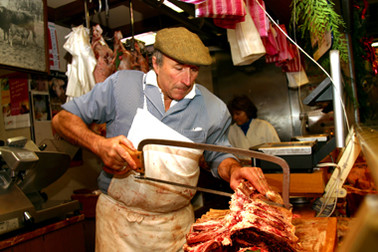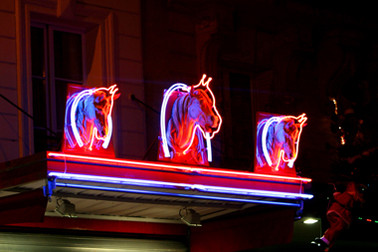Horse stepping back on plate?
January 23, 2007 - Agence France Presse

It was a sign of the times when the horse butcher featured in the French blockbuster film “Amelie” closed for good.
The small horse’s head above the door that Amelie points to as one of her favourite Parisian landmarks disappeared a couple of years ago, along with the butcher, and the old red iron gates, now painted blue, serve as the entrance to a mobile phone store.
Though eating horse is considered taboo in many cultures, particularly in English-speaking countries, it has been part of French life since late in the 19th century.
But while meat in general remains popular in France, horse appears to be riding into the gastronomic sunset. According to statistics from the French Meat Information Centre, the CIV, horse butchers fell from almost 1,300 to under 1,000 between 1999 and 2002 alone.
Yet a handful of chefs and horse-meat lovers are doing their best to revive the taste.
Many French people believe it is healthier than other meats. “Horse-meat is relatively low in fat and high in iron,” said Xavier Panier, a doctor specialised in nutrition and homeopathy. “The food horses eat is more natural and the meat easier for our bodies to assimilate.”
 Neon horse heads above the entrance to a Parisian horse butcher. Though the number of bouchers chevalines has gone down significantly in the last 30 years, horse is making a curious leap back onto plates at a few restaurants in the city of light. (PHOTO BY JOE RAY/REPLACES FILE PHOTO)
Neon horse heads above the entrance to a Parisian horse butcher. Though the number of bouchers chevalines has gone down significantly in the last 30 years, horse is making a curious leap back onto plates at a few restaurants in the city of light. (PHOTO BY JOE RAY/REPLACES FILE PHOTO)In contrast however with beef producers, who survived problems with mad cow disease, the French horse meat industry has not recovered from a set of trichinosis scares over the past 30 years.
After wiping horse off menus, today several Parisian restaurants including Les Crocs, Les Pissenlits Par La Racine, Sardegna a Tavola and Le Taxi Jaune, have put it back on and customers are eating it up.
Artisan butcher Michel Brunon, who runs his eponymous butcher shop in the Beauvau covered market in eastern Paris, supplies horse-meat to three of these restaurants and has no trouble understanding this mini-renaissance.
“It’s a tradition and it’s a taste,” he said while arranging cuts of horse which include entrecote, filet and tournedos.
The trouble is that while most aficionados like Brunon say horse is similar in flavor and texture to beef, mentally it’s still an acquired taste.
“We used to eat it when I was little,” said Gaelle Bienvenu, 20, who works for Brunon, “but when I found out it was horse, I said, ‘Never again.’”
“You can’t eat it if you think of horses galloping on a beach,” she continued, while transforming a side of meat into small cuts, “and that’s about all it takes to turn most people off.”
Her boss Brunon took over his space eight years ago from a dedicated horse butcher whose sales had nose-dived.
The first Parisian horse butcher opened in 1866, responding to the needs of poorer clients who wanted good meat at a low price. A few years later, when the city came under siege from Prussians, horse saw a huge boost in consumption. And in recent years, horse butchers offered an emergency solution on Mondays by remaining open when other food stores were closed for their weekly break.
“Luckily, I sell other stuff,” Brunon said. “Rough estimate: I might sell a kilo of horse for 15 of beef, but when people buy it,” he said, plopping down a large order for an older client, “they buy a lot. They either avoid it, or they eat tons.”
Chef Otis Lebert falls into the latter category. He so enjoys preparing and selling horse that he doesn’t sell beef at his Parisian restaurant, Le Taxi Jaune.
“Do people complain about no beef? Yep! But they can go elsewhere,” he said. “Anyone who wants meat can eat horse.”
At home, he practices what he preaches. “We did a Franco-Japanese dinner at home the other night where I made a horse tartare with wasabi and olive oil,” he said. “It was excellent.”
For Lebert, the biggest challenge and greatest reward is getting people to enjoy something they thought they would hate. “Even Americans, if they’ve lived here a while, will try it,” he said.
Lebert started by offering a classic entrecote and now, as long as he can get it from his butcher, he likes preparing a plump French cut called the poire which he prepares Rossini-style, with a generous slab of foie gras that melts over the top.
He is not alone in his enthusiasm for horse.
Alexandre Lazerges is the founder of the “Poney Club,” a group of people who meet once a month at Les Crocs, and eat horse. “Rule number one for the Poney Club,” he said at a smoky neighborhood bar, “is if you don’t eat horse, you’re not in the club.”
But for Lazerges, who runs the culture section of French magazine Technikart, the idea of the Poney Club is more to be a social and networking circle for hip 20- to 30-somethings than to be a showcase for horse meat.
“(Eating horse is) a special touch for the group. It’s not the objective, but it’s fun,” he said. He’s also hooked. When he gets a call, his cell phone doesn’t ring - it neighs.
When asked what he has learned about horse meat since he founded the club, his answer is 100 percent carnivore. “That it’s good.”
But asked whether 10 years down the line, 2007 would go down as the year that marked a horse renaissance, both Brunon and Lazerges gave just a Gallic shrug.
Chef Lebert had a different response. “I’m just getting going.”
This article also ran with: Yahoo News, Food24.com, Mediacorp News, Channel NewsAsia, The Tocqueville Connection.